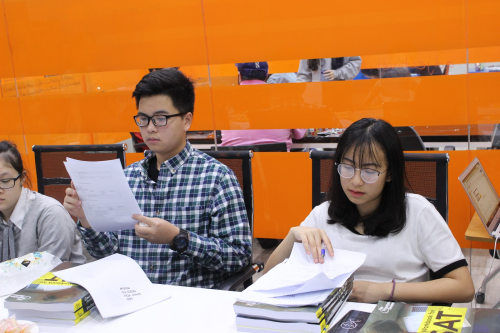5 tips for writing SAT writing
The Writing and Language section of the SAT requires you to be fluent in grammar and how to use English effectively.
The Writing and Language section of the SAT requires you to be fluent in grammar and how to use English effectively. This section consists of 44 sentences in 35 minutes - you have less than a minute to complete each question. The following tips will help you overcome this section effectively.
Reading while answering the question
With 48 seconds for each question, you almost don't have time to read them all. You must know how to skim to understand the main idea and the writing. When you begin to see the underlined part, you need to simultaneously identify the type of question and choose the most appropriate answer.

Long questions do the following
In addition to underlined sections throughout the article, there will be questions about paragraph or sentence arrangements. With this format, it is necessary to read the whole article, so it is best to read the entire article before doing it.
Choose short answers and links
If you have more than one answer with the same grammar, choose a shorter answer. In addition, if an answer is off topic, it is always eliminated. The correct answer is always related to the topic of the article.
Know the rules of punctuation
About two sentences in each Writing section will check the punctuation, and you must master the following sentence rules:
- Commas (,) are mainly used in the following 4 cases:
List 3 or more objects (apples, bananas, and oranges)
Separate individual subject-predicate clusters with FANBOYS (For, And, Nor, But, Or, Yet, So) (My mom was going to pick me up from school, but my dad came instead.)
Introducing the context (In 2008, the Phillies won the World Series.)
Minor components in the sentence (I ran across the floor, which was painted with school colors, to meet Steve.ORI ran across the floor to meet Steve, who greeted me with a high five.)
- semicolon (;) to separate complete clauses without FANBOYS. The two sides separated by semicolons must be complete clusters of clauses. (I entered the competition early; however, I decided to withdraw a week later).
- The colon (:) is used to introduce or emphasize short phrases, quotes, explanations, examples or lists. Before the colon, there must be a complete subject-predicate cluster. (The greatest obstacle to completing my homework was imminent: the finale of Gray’s Anatomy.)
- Hyphens (-) have two purposes:
Break sentences to emphasize (I saw John the other day and he looked great — no, it was actually Greg.)
List examples or explain (Many facets of Jill’s personality — among them empathy, respect, and kindness — make her a great friend and human being.)

- The apostrophe (‘) has two purposes:
Own ways (Bob’s book, my friends ’phones)
Abbreviations (there’s the rabbit, exported important, who’s in charge)
Understand the connection between the arguments
The question in Writing and Language examines how to connect ideas effectively. In general, there are 4 relationships you need to know, and you should choose the right conjunctions to show the relationship. When you see an underlined noun, ask yourself "How are ideas related to each other?"
- Complement is the relationship using the words in addition, furthermore, for example, and also.
- The opposite is a relationship using the words however, on the other hand, despite, and unlike.
- Cause, the result is a relationship using consequently, therefore, since, and because words.
- Order is a relationship using the words first, then, afterwards, and finally.
American Study is the leading US SSAT / ACT / SAT / IELTS / TOEFL exam preparation and study abroad consultancy. With the US exam preparation technology and curriculum, the organization has helped many students achieve high results on standardized tests.
American Stydy teachers are carefully selected and trained according to The Princeton Review USA standards. The teachers are all graduated from top 10-20 universities in the US and have many years of experience in teaching, exam preparation and studying abroad for international students.
This year 131 international organizations, from 73 countries, partnered with the PRA in Washington, D.C., and its Hernando De Soto Fellow Prof. Sary Levy-Carciente to produce the 17th edition of the IPRI..
Email: [email protected]
The articles on Buyinnigeria are collected by us on the internet. If you find any infringing articles, please contact us and we will delete them immediately. Thank you!
Copyright 2004-2024 www.buyinnigeria.com.ng , all rights reserved.